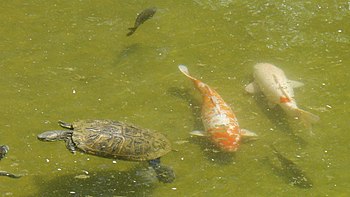 |
| Male seahorses are pouch brooders (Photo credit: Wikipedia) |
Seahorses are cataloged in the genus Hippocampus. The members of this genus belong to the family Syngnathidae. This family contains over 50 individual species including all seahorses and their close relatives the pipefish. Seahorses are found in shallow waters of tropical and temperate zones around the world.
The name Hippocampus is first recorded in Greek poetry. Hippos mean horse and campus translate to sea monster. Ancient Greeks and Romans believed seahorses were a gift from the sea god Poseidon/Neptune. Despite their fragility, seahorses were perceived to be a symbol of strength and power. There are three species of seahorse found in the Mediterranean Sea. These are the Hippocampus hippocampus or long snout, the Hippocampus brevirostris or short snout, and the Hippocampus fuscus which emigrated from its native habitat in the Red Sea. Many Europeans thought these equine-like creatures bore the souls of recently departed sailors, providing them safe passage to the underworld and protecting over them until their souls meant their destiny. Seahorse fossils have been discovered dating as far back as 13 million years. Here we will focus both the seahorse collectively and one specific species Hippocampus kuda also known as the common seahorse.
The common seahorse is indigenous to the Indo-Pacific. Twenty-three countries have confirmed the presence of H. Kuda ranging as far south as Australia to as far north as China.
Seahorses have been procured by Chinese herbologists for their purported healing qualities for centuries. Native populations throughout Indonesia and the Central Philippines also use seahorses as a component in herbalistic medicines. It is estimated that up to 20 millions seahorses a year are harvested to support this thriving industry. Overfishing has driven seahorse populations to the verge of becoming endangered species. The common seahorse is currently listed as a vulnerable species by CITES (the Convention on International Trade in Endangered Species of Wild Fauna and Flora, also known as the Washington Convention). CITES has regulated the import and export of seahorses in this region of the world since 2004. Unfortunately, Indonesia, Japan and South Korea do not recognize the trade rules put in place by the Washington Convention.
Seahorses are a boney fish. They are devoid of scales. They have a thin layer of skin stretched over a series of bony plates arranged in rings. Each individual species has a specific number of these rings. Seahorses have a cornet on their heeds. These cornets are distinctive to each seahorse. No two are identical much like a human fingerprint.
These creatures swim vertically, a trait specific to seahorses. They are poor swimmers who move very slowly in the water. Propulsion is achieved by the rapid flutter of the dorsal fin on their backs. They maneuver with the use of their pectoral fins located behind their eyes. They do not possess a caudal (tail) fin. In its place, there is a prehensile tail which they warp around stationary objects to anchor themselves.
In an aquarium, seahorses must be provided with objects to anchor themselves to. Coral and small branches will suffice nicely. These are timid creatures that should never be housed with even moderately aggressive species. They are easily stressed. Prolonged periods of stress will lower the efficiency of their immune system making them more susceptible to disease. Gobies and other docile mannered fish will make suitable tank mates. Seahorses are primarily bottom dwellers. They will peacefully coexist with ornamental crustaceans and other bottom feeders. This makes them the perfect compliment to a marine reef aquarium.
The amateur aquarist should not attempt to raise seahorses. You will only accomplish the unnecessary death of a rapidly vanishing species. Seahorses are only recommended for the more experienced saltwater aficionado.
All seahorses are carnivorous. They use their snouts to suck in zooplankton as a source of nutrition. Upon initial introduction to a home aquarium, seahorses may only eat live food offerings. Rotifers, mysis and brine shrimp should help persuade them to start feeding. With patience, they can be weaned off of live food. These are slow feeders and must not be made to compete for their food.
In recent decades the captive breeding of seahorses has become increasingly widespread. The common seahorse is among these commercially raised specimens. Farm raised seahorses may already be acclimated to non-living food offerings. These are commonly more expensive than wild caught seahorses. However, you have a specimen that will not have to endure the shock and trauma of being yanked out of its natural habitat and placed in the confines of an aquarium. Farm raised marine species are more disease resistant and have a much higher survivability rate. And you will not be a participant in the further depletion of an already threatened species.
If you find the idea of raising seahorses intriguing, then you should check out the hottest new trend in the saltwater aquarium industry, Jellyfish Fish Tank Aquariums. Keeping Moon Jellyfish & Pet Jellies is the hottest new trend among saltwater aquarists.
Article Source: EzineArticles
|







